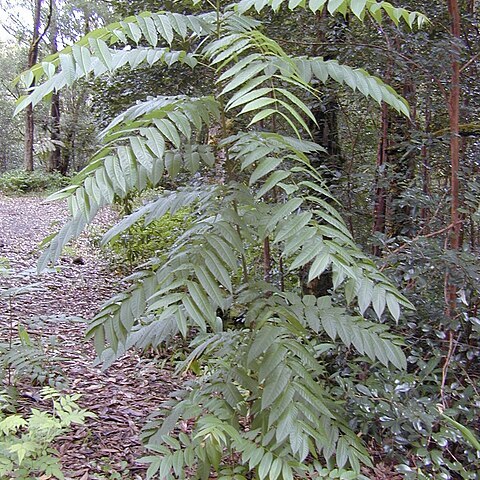Medium-to large-sized tree to 35 m tall and 152 cm girth; bole to 22 m, with or without buttresses (to 3.5 m); crown usually rounded and spreading, occasionally dense. Bark greyish-white to brown, usually fissured and flaking; inner bark brown to reddish, fibrous; sapwood white to pink or red; smelling strongly of cedar when cut. Leaves (15 –)26–69 cm long, usually (5–)9–15-jugate; rachides glabrous to sparsely pilose, often reddish; petioles 6–11 cm long, glabrous to pilose. Leaflets lanceolate to ovate-lanceolate, margins entire, (7–)9–12.8(–16) by (2.2–)3.2–5(–6) cm, glabrescent with hairs on upper midribs rare, apex acute to acuminate, base usually asymmetric; petio-lules 0.2–1 (–1.4) cm long, glabrescent. Inflorescences up to 55 cm, pendent, fragrant; rachides pilose to pilose-villous with short to long, spreading or appressed hairs; pedicels 0.5–1 mm, usually pilose, occasionally villous. Flowers 3.5–5(–6) mm long. Calyx 0.75–1.25 mm long, usually glabrescent externally, lobes imbricate; sepals spathulate, (0.4 –)0.75–1 by (0.5–)0.75–1.25 mm, margins ciliate. Petals white to creamy-white, 3.5–5.8 by 1.3–3.1 mm, usually glabrescent occasionally pilose externally, margins ciliate with long hairs. Androgynophore (1.75–)3–4.9(–5.5) mm long. Filaments 1.25–2.5 mm long (male flowers), 0.75–1.75 mm (female flowers), glabrous to pilose/ villous. Anthers 0.6–1.1 mm long, 0.4–0.9 mm broad, apices usually apiculate, often with long appendage. Antherodes 0.5–0.9 mm long, 0.3–0.6 mm broad, usually sagit-tate, often with long apiculate appendage. Disk 1.25–2.5 mm diam., reddish-orange, densely pilose. Ovary 1.25–1.8 mm diam., moderately pilose; locules to 8-ovulate. Style 1.2–3 mm long, 0.2–0.4 mm broad (male), 0.3–1.5 mm long, c. 0.3 mm broad (female), glabrous; stylehead 0.75–1.25 mm diam. Capsule 15–20(–25) mm long; columella 15–20(–24) mm long, 5–7(–10) mm broad, concave with apical scarring; valves reddish-brown, smooth to lenticellate with small (0.1–0.5 mm diam.) scattered lenticels. Seeds winged at both ends, 11–19 by 2.5–4(–5.8) mm, wings unequal, api-ces narrowly obtuse; seed body 5–7 by 1.2–3 mm.
Deciduous tree to 40 m tall with bole to 3 m diam. and buttresses to 3.5 m tall; bark flaking irregularly. Leaves usually 15–50 cm long, usually 4–10-jugate, usually glabrescent with hairy domatia in axils of veins of leaflet abaxial surface, red when young; petiole 4–11 cm long; leaflets usually 4–10 cm long, 1.5–5 cm wide, ovate to lanceolate or even subfalcate, asymmetric at base, acuminate at apex; petiolules usually 4–10 mm long. Thyrses to 50 cm long. Sepals spathulate; margins ciliate. Petals usually 4–5 mm long, white; margins ciliate. Stamens usually 5; filaments pilose; staminodes absent. Style glabrous. Capsule to 26 mm long, 8 mm wide, ellipsoid, opening by lenticellate valves. Seeds 4–7 per locule, winged at both ends.
NB Naming of plant confused. A large spreading tree. It loses its leaves. It grows 15-25 m high. The trunk is thick. The bark is dark grey and rough. It cracks into squares. The leaves are large and compound. They can be 90 cm long and have 10-14 pairs of narrow leaflets. These are 15 cm long. They have unequal sides. They taper to the tip. The edges are wavy. The veins are light green. The flowers are bell shaped. They are small and white. They occur in long sprays. The fruit are brown capsules. They split open in a star shape. The seeds have wings.
Tree up to 25 m. tall.. Leaflets 10–24, entire, lanceolate or lanceolate-elliptic, up to 15 × 5 cm., gradually tapering from near the base to the long, narrow, attenuate-acuminate apex; proximal lateral nerves on lower surface with minute deltate axillary pockets (domatia) with minute apical hairs.. Inflorescence up to 35 cm. long.. Capsule delicate, 1.5–2 cm. long, valves without conspicuous lenticels.. Fig. 13/7–12.
Tree, up to 25 m high. Leaves pinnate; leaflets entire, lanceolate to ovate. Inflorescence paniculate. Capsule 20 mm long. Flowers white.


